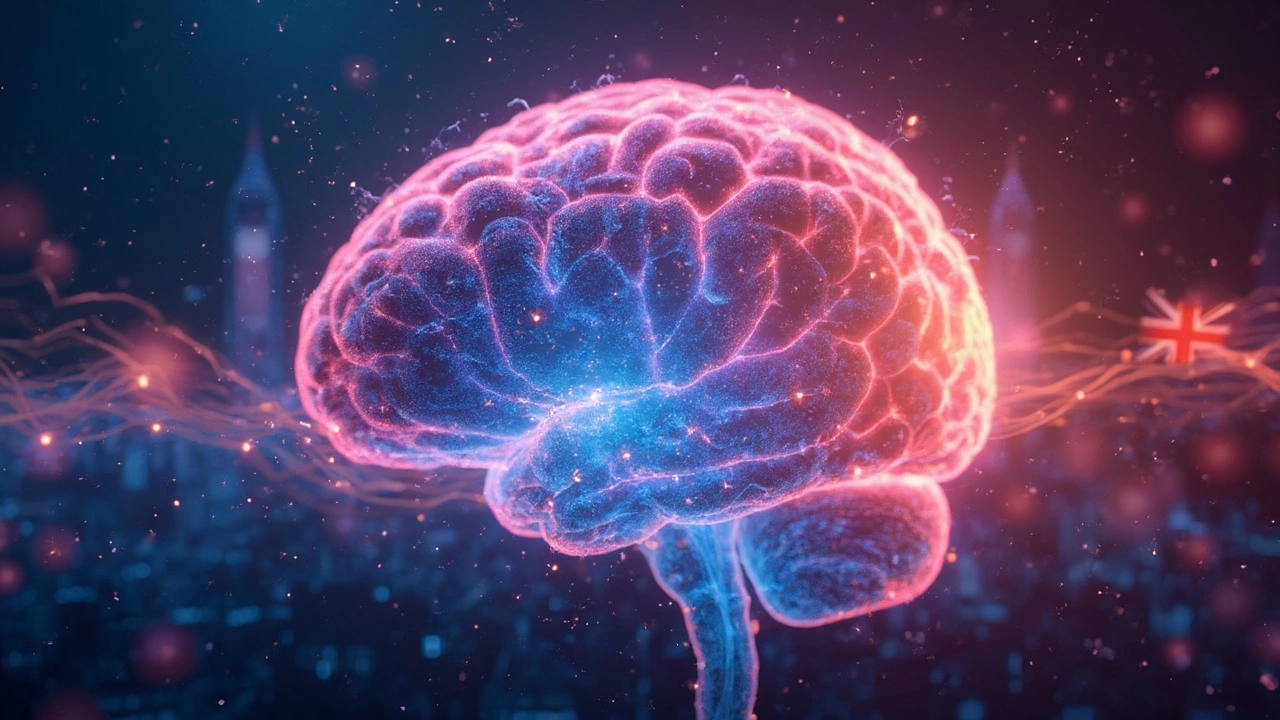Imagine hurting every single day and feeling like nothing helps. That’s what it’s like for millions of people living with chronic pain. Here’s the surprise: your brain can actually learn to tune pain down. Yep, you read that right — your brain can help turn the volume down on pain, almost like reaching for a remote control.
Doctors used to think pain only lived in the body. Now, brain scans prove it’s a much bigger story. The brain can amplify pain signals, or deflate them, based on how you think and what you focus on. This isn’t just wishful thinking—study after study backs it up. If you train your mind the right way, the brain rewires itself, making pain less of a dictator in your life.
Most people don’t get concrete advice about what to actually DO about brain-fueled pain. That’s about to change. In this article, you’ll get easy-to-try brain training tips, learn how stress amps up those pain signals, and find out how mood swings can make a difference you can really feel. Ready to finally feel like you’ve got some say in your own body? It’s a game-changer, and it starts with understanding what’s actually happening in your head.
- Breaking Down Chronic Pain: More Than Sore Muscles
- The Brain’s Secret Superpower: Neuroplasticity
- Tools That Really Work: Retraining Techniques
- The Stress-Pain Loop: Why Your Mood Matters
- Building Your Brain Training Game Plan
Breaking Down Chronic Pain: More Than Sore Muscles
Most people hear "chronic pain" and think it’s just a sore back or an achy joint that won't go away. The truth is, it’s way bigger than nagging pain in one spot. Chronic pain is like an alarm system that gets stuck in the 'on' position, even when there’s no real danger.
It happens when pain signals in the nerves keep firing for months, sometimes years, even after injuries heal. The bad news? This messes with your sleep, your mood, and your energy. The even weirder news: the brain and nervous system can actually become more sensitive the longer pain hangs around. It’s like your pain sensor is stuck on max volume.
Doctors call pain "chronic" if it lasts longer than 3 months, messes with daily life, and doesn’t match up with what’s happening in your body. Surprisingly, over 20% of adults in the U.S. deal with this kind of pain, and most aren’t older folks either. It can hit anyone at any age. Here’s a look at the basics:
| Fact | What It Means |
|---|---|
| Chronic pain affects* | More than 51 million U.S. adults (2024 CDC estimate) |
| Common causes | Back pain, arthritis, headaches, nerve damage, fibromyalgia |
| How long it lasts | More than 3 months |
| Other problems | Often leads to anxiety, depression or trouble sleeping |
But here’s something hardly anyone talks about: chronic pain is shaped just as much by your brain and nerves as by your sore muscles or joints. You can have daily pain without any obvious injury, because once your brain gets "good" at feeling pain, it doesn’t need a strong physical trigger anymore. That's why two people with the same injury can feel completely different—it's all about how their brains are wired now.
If you feel like you’ve tried every lotion and pill out there with no luck, it’s not all in your head—but your brain really is a big piece of the puzzle. Understanding this opens the door to new solutions, and that’s what the next section is all about.
The Brain’s Secret Superpower: Neuroplasticity
Most people think their brains are like set-in-stone machines, but that’s not even close. Your brain is more like a plastic mold that keeps reshaping itself, a process called neuroplasticity. This is awesome news if you have chronic pain, because it means your brain can literally rewire how it handles pain signals.
Here’s what’s wild: Brain imaging scans show that people with long-term pain often have changes in the areas that process pain, mood, and memory. But those same brain regions can dial down pain intensity if you train them with the right strategies. It’s not magic. It’s just brain science in action.
Think of neuroplasticity as your brain’s ability to make new connections, strengthen certain pathways, and shut down ones that aren’t helping. For pain, that means you can actually teach your brain to react less to the ache or sting you feel each day.
You might be wondering how powerful this really is, so check out these facts:
| Neuroplasticity Fast Facts | Description |
|---|---|
| Speed of Change | Daily practice (like mindfulness or graded exercise) can trigger brain changes in as little as 2-4 weeks. |
| Pain Response | Studies show people can lower their pain ratings by 40% with brain training techniques. |
| Brain Growth | Imaging studies reveal increased gray matter in the prefrontal cortex (the thinking part of your brain) after regular brain training. |
Some key ways neuroplasticity works in your favor with pain include:
- Turning down your brain’s pain alarm system, so normal signals aren’t mistaken for severe threats.
- Strengthening pathways involved in relaxation and comfort, making them easier to find when pain flares up.
- Weakening the link between pain and stress or negative mood, so pain stops running your life.
Bottom line? Your brain isn’t stuck. It can change, and those changes can make chronic pain way less powerful—if you give your mind the right tools and practice.

Tools That Really Work: Retraining Techniques
Okay, let’s get practical. Training your brain to dial down chronic pain isn’t magic, but it is doable with simple tools—straight from experts and real people who’ve been there. The trick is consistency. You don’t have to do everything at once, but a few new habits can really get your brain on your side.
1. Mindfulness Meditation
If you’ve ever heard someone talk about "mindfulness,” they’re onto something. A 2022 study from Stanford showed that pain patients who practiced just 10 minutes of mindfulness daily actually rewired parts of their brain linked to pain. All you need is a quiet spot and a timer. Focus on your breath or sounds for a few minutes. When pain grabs your attention, just notice it, then gently shift back to the breath. It sounds basic, but it gives your mind practice at not panicking every time you hurt.
2. Graded Motor Imagery
Here’s an odd but powerful trick: mentally rehearse moving parts of your body that hurt—even if you can’t move them for real. Researchers found that athletes and stroke patients use this to heal faster, and pain clinics use it too. For example: if your knees hurt, imagine standing up and walking with ease, once a day. The point isn’t pretending you’re not in pain—it’s building new brain pathways that signal safety instead of threat.
3. Cognitive Behavioral Therapy (CBT)
CBT sounds technical, but it’s just about catching negative thoughts and flipping them. One well-known pain doctor, Dr. Beth Darnall, runs programs that help people notice stuff like “I’ll never get better” and swap it for “I’m working on it, and progress is possible.” Apps like Curable or online guides can coach you through exercises in your own time, often for free or cheap.
4. Movement, Little by Little
When you hurt, it’s tempting to do nothing. But staying still actually teaches your brain to expect pain with every move. Try this: pick the gentlest possible movement (maybe stretching fingers or standing for a minute), do that daily, and add a little more every week. Over time, your brain learns not every move equals pain, so it doesn’t sound the alarm as fast.
- Mindfulness: Set a two-minute timer, close your eyes, and notice your breathing.
- Imagery: Picture yourself doing a pain-free activity, like taking a walk in your favorite park.
- Thought Flipping: Write down one negative thought about pain, then write a more helpful version under it.
- Gentle Movement: Wiggle toes, roll shoulders, or try guided online chair yoga for five minutes.
If you try these for a couple of weeks—even just picking one tool—you might start to notice shifts. It’s not a miracle cure, but day by day, your brain literally learns new tricks. That’s not theory anymore; it’s proven science. The best thing? These tools put some power back in your hands for once.
The Stress-Pain Loop: Why Your Mood Matters
If you feel like your pain gets worse when you’re stressed or upset, you’re not imagining things. Stress and mood swings can light up your body’s alarm system, turning mild aches into full-blown agony. This link between emotions and chronic pain is called the stress-pain loop—and it’s a trap that’s way too easy to fall into if you don’t know what’s happening.
Here’s what’s really wild: your body’s stress hormones (think cortisol and adrenaline) tell the brain to pay more attention to pain signals. When you’re under a lot of pressure—maybe after a rough day at work or a fight with someone at home—your brain gets stuck in "danger mode." It starts scanning the body for anything wrong, and even small pains can feel ten times stronger.
Look at the numbers. According to a 2023 study in the Journal of Pain, people with high daily stress reported their pain as 30% worse than those who felt calmer. That’s not just a small difference. And if you struggle with anxiety or depression, your risk of intense pain is even higher. The worst part? Feeling more pain makes your mood crash, and suddenly you’re stuck in a nasty spiral that feels impossible to break.
| Factor | How It Affects Chronic Pain |
|---|---|
| High Stress | Increases pain signals by up to 30% (Journal of Pain, 2023) |
| Anxiety | Boosts pain intensity and frequency (Mayo Clinic) |
| Poor Sleep | Can double pain sensitivity (Harvard Health) |
| Low Mood/Depression | Makes pain feel worse, recovery harder |
So what does this mean for your chronic pain journey? You’ve got way more control than you think, just by tackling stress and boosting your mood. Little changes—like getting outside for fresh air, calling a friend for a laugh, or setting boundaries when work piles on—can help your brain chill out and dial down those pain alarms.
- Try guided breathing or meditation apps; they’re proven to calm the mind and slow pain signals.
- Keep a mood journal to spot triggers. Seeing what sets you off means you’ll catch the cycle sooner.
- If you feel stuck, don’t tough it out alone. Talking to a mental health pro can shrink those pain spikes fast.
Simple daily choices really make a difference. Pain and stress love to team up, but you don’t have to let them run the show.

Building Your Brain Training Game Plan
So you want to train your brain to beat chronic pain—not just wish it away, but really make a difference every day. Here’s what works, based on real science, not just hype. Chronic pain isn’t only about injured nerves or joints; the brain decides how much pain you actually feel. That means your daily habits and choices matter more than you ever thought.
A few easy tools can start the circuit rewiring in your brain:
- Mindfulness Meditation: Studies from Harvard in 2022 showed just 10 minutes a day of mindfulness meditation shrunk pain intensity for 30% of people with back pain. Start with a simple app or YouTube video to guide you.
- Graded Activity: Don’t let fear keep you on the couch. Start moving in tiny steps (like two minutes of walking). Gradually build up. This keeps your brain and body from expecting pain every time you move.
- Pain Journaling: Write down what your pain feels like, when it’s better, and possible triggers. Patterns pop out that help you spot what your brain is reacting to—and what’s helping.
- Positive Visualization: Picture your body moving easily, without pain. Athletes actually use this to improve performance. Your brain activates the same areas as if you’re really doing it.
Want to know what really ramps up brain training? Catch your stress before it spikes. If I wait until I’m already stiff and cranky, everything gets worse. Victor sometimes jokes my "pre-pain routine" is longer than my email inbox, but it actually helps.
| Brain Training Habit | Minutes Needed Per Day | Proven Benefit |
|---|---|---|
| Mindfulness Meditation | 10 | Reduces pain perception |
| Graded Activity | 5-15 (to start) | Improves movement, lowers fear |
| Pain Journaling | 5 | Spot triggers & trends |
| Positive Visualization | 3 | Boosts control, lowers anxiety |
The real trick is to choose two or three of these and stack them into your morning or evening routine, just like brushing your teeth. Go small, but stick with it—neuroscientists say it takes about 6-8 weeks to rewire pain habits in the brain. Getting support helps too. Whether it’s a close friend, your doctor, or one of the many online groups for pain brains, don’t go it alone. You’re not supposed to tough this out by yourself. A team makes your plan doable—and more likely to stick.
